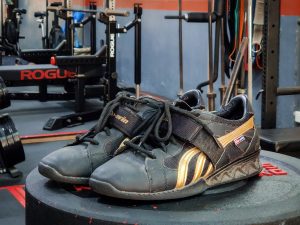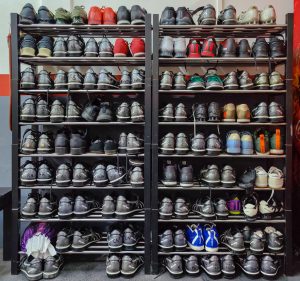“Lifting shoes? Nah, I’ll just wear my Converse/Met Cons/running shoes.” Or, “I’m new to this, I don’t need them now. Maybe I’ll get them after I’m able to lift X kg.”
We hear this a lot, especially from people who are just starting out with barbell training. They hesitate to get a pair of “special” weightlifting shoes, because they’re new and don’t want to make an extra purchase, or because they just don’t think it’s necessary. We get that.
But the truth is, proper lifting shoes aren’t just a nice to have, but rather a MUST have when you’re training with barbells. Here we explain why you need a pair, what to look out for and how to buy them.
Ditch your running shoes, try on a pair lifting shoes
If you play tennis, it’s very likely that you’ll get a pair of tennis shoes, right? The same goes for golf, running, cycling, etc. Every sport has its own specialist equipment designed to make training better, more comfortable and/or more effective. Nobody’s stopping you from training in generic running shoes, but it’s not optimal.
Not convinced? Let’s try this. The next time you visit us, train in whatever shoes you want for a couple of sets. We’ll then loan you a pair of lifting shoes in your size. Try them on and perform the same lift again.
Feel the difference in stability
Every single time we’ve done this, the non-believers get converted.
Without fail, our clients will tell us that they feel an obvious difference from the moment they do their first set of squats in lifting shoes. They feel much more stable – their feet are planted better, and it gets easier to assume the bottom position of the squat. That’s why we’re so insistent on wearing lifting shoes.
Not part of our gym (yet)? Don’t take our word on it. Borrow a pair from a training buddy and try them out before you decide for yourself. We guarantee that you’ll prefer them. Not a single time have someone said that the lifting shoes were worse to train in than their original pair of shoes.
What to look out for in a weightlifting shoe
Not all shoes are created equal. Unlike generic sports shoes, good lifting shoes must have all the following components:
– Non-compressible soles
– Raised heel
– Metatarsal straps
Each part is designed to benefit lifters in specific ways.
Non-compressible soles: creates stability and efficient force transfer
Your shoes are your contact point with the ground. During a squat, you can generate more force when you push against the ground, if your base is stable.
The force created will be transmitted up from the floor, through your body, and into the barbell. If your force is efficiently transmitted, you can theoretically lift more weight, because no energy is wasted compressing the sole of your shoes.
Lifting shoes are designed with hard, inflexible soles that allow you to push firmly against the ground. In contrast, regular shoes have much softer foam or rubber soles that compress easily and presents an energy leak.
Are you more stable squatting on a bouncy castle or on a concrete floor? Would you rather waste energy compressing the sole, or use all of it to push the bar up?
Non-compressible soles are usually plastic, wood or stacked leather. Some soles are made of hard, high-density foam; while they’re more solid than regular shoes, they still allow small amounts of compression. You can test them by pressing a finger on the sole – if it compresses, don’t buy it.
Raised heel: increased quad recruitment
Lifting shoes have heels that are usually raised by ½ to ¾ inches. During a squat, the elevated heel inclines the shin forwards, which lets the knee track a little more forward and allows a little more usage of the quadriceps.
Does this mean a higher heel height is better? Well, it depends.
While there are shoes with 1-inch heels, they’re mostly used for Olympic lifting, where the higher heel helps the lifter descend further under the bar in the clean or snatch.
Your ideal heel height will depend on your anthropometry. For most people, a ½-inch heel will work. If you have short tibias (lower legs) and long femurs (thighs), or a long torso and short femurs, you can go with flatter shoes. If you have long tibias and short femurs, a taller heel may be better. If possible, try them on and see which one you prefer.
Metatarsal straps: provides extra support and secures the feet
When pushing against a heavy barbell, your feet may pronate or supinate, which means that they roll in or out instead of staying solidly flat on the ground. If the shoe isn’t snug, your feet can also shift around inside the shoe. Either of these will lead to decreased efficiency.
In general, any looseness in the shoe will cause instability and decrease force transfer.
Lifting shoes have an additional strap that wraps across the top of your foot, preventing it from moving inside the shoe. When well secured, they also provide additional lateral support.
A good metatarsal strap should come out of the arch-side of the shoe, at the inward curve of the mid-sole, and wrap the foot around the instep.
Where and how to buy lifting shoes
Even though barbell training has become pretty popular, lifting shoes are still a specialist item and most brick-and-mortar sports stores won’t stock them. They’re available online, but getting the correct size can be tricky.
Your best bet would be to try on a buddy’s shoe. If that’s not possible, read product reviews for specific models. Pay attention to how others describe the sizing – whether it runs big or small compared to their usual size. Usually, that’s enough information to guesstimate your size for that model. But if you’re still unsure, choose the size that fits a little more snug.
Also, different brands have different toe box sizes. For example, Do-Win shoes tend to have a wider toe box. Make sure you do your research and get a shoe that best matches the width of your foot.
How much does a lifting shoe cost?
A normal pair can cost anything from sub-$100 to $400, with vintage shoes sometimes going for more than $1000 (all estimates in SGD).
But more expensive doesn’t always mean better. You don’t have spend $400 for a pair of lifting shoes. In fact, most of our clients’ shoes are around the $100 mark.
Also, they should last you a long time. Lifting shoes don’t get a lot of mileage, because you’ll only use them for a few hours per week in the gym.
Do-Wins are pretty popular at our gym
A smart investment if you’re serious about weightlifting
It’s important to have the right gear. You don’t need gloves or special clothing, but shoes are necessary.
It doesn’t matter if you see yourself as a recreational lifter, or if you’re just starting out. If you’re even a little bit serious about lifting, the only accessory you MUST have is a pair of lifting shoes.
We’ve seen it over and over – when our clients finally invest in a quality pair, they all wish that they’d done it sooner. The right shoes make a big difference in your efficiency, control and technique. Get your pair of lifting shoes now!



